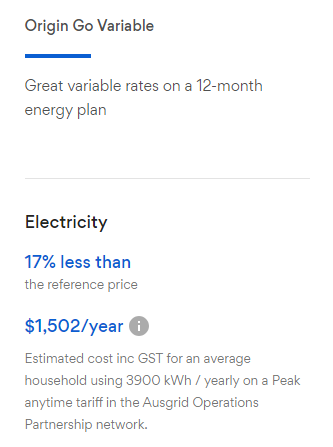KEY POINTS
- The electricity reference price serves as a price cap for energy retailers, providing a benchmark for consumers to compare energy plans.
- The electricity reference price is used across NSW, SEQ and SA.
- Victorian customers have an electricity reference price known as the Victorian Default Offer (VDO).
The energy retail market has changed in recent years, as a result of overly confusing and sometimes misleading energy plans. Government regulators introduced the electricity reference price to simplify the market.
This Canstar Blue guide explains what the government’s electricity reference price is, how it works and the relevant costs for each state or territory.
On this page:
- What is the electricity reference price?
- How does the electricity reference price work?
- Understanding your electricity plan
- Getting a better energy deal
- Use the electricity reference price to compare electricity plans
- What happened before the electricity reference price?
- Where is the electricity reference price used?
- Key points about the electricity reference price
- How much is the electricity reference price?
- Is staying on the electricity reference price a good idea?
What is the electricity reference price?
The electricity reference price acts as a price cap for energy retailers, in addition to providing a consistent point of reference for consumers to compare energy plans. The idea is that energy retailers display how their prices compare to the electricity reference price, so consumers know where they stand when it comes to finding a competitive deal.
Electricity retailers can still charge more than the electricity reference price through their market offers. It appears that this is discouraged by the government’s regulators, even if the retailer may have reasonable claims to charge more than the reference price (i.e. because it offers an additional value-add incentive that makes the product appealing).
How does the electricity reference price work?
The government reference price, also called the electricity reference price, is a safety net price for electricity customers who don’t engage in the energy market (i.e. compare and change electricity offers regularly). The electricity reference price is set by the Australian Energy Regulator (AER) and is based on specific energy usage and supply charges in different geographical areas.
Because of this, the reference price will vary between states and distribution zones. All energy retailers must offer customers the electricity reference price, which is updated every July to reflect the costs of supplying energy.
Understanding your electricity plan
Understanding your energy plan and usage charges will help you begin the comparison process and ensure that you get the best energy deal.
If you haven’t compared and switched energy providers or energy plans in the last 12 months, then there’s a high chance you’re paying the default market price or standing offer in your state.
Market offers normally have competitive prices, are cheaper than the market offer and most have special offers or discounts, though they may have terms and conditions that will need to be met in order to be eligible.
Getting a better energy deal
Now with a better understanding of your current plan, you can compare different offers to find the best option for your energy needs. It might also be a good idea to check whether you’re eligible for any concessions or rebates.
You can start with the table below, which shows a comparison of the cheapest deals on the Canstar Blue database, with the plan’s savings compared to the electricity reference price.
Here are some of the cheapest published deals from the retailers on our database that include a link to the retailer’s website for further details. These are products from referral partners†. These costs are based on the Ausgrid network in Sydney but prices may vary depending on your circumstances. This comparison assumes general energy usage of 3900kWh/year for a residential customer on a single rate tariff. Please use our comparison tool for a specific comparison in your area and to see other products in our database that may be available. Our database may not cover all deals in your area. As always, check all details of any plan directly with the retailer before making a purchase decision.
Here are some of the cheapest published deals from the retailers on our database that include a link to the retailer’s website for further details. These are products from referral partners†. These costs are based on the Energex network in Brisbane but prices may vary depending on your circumstances. This comparison assumes general energy usage of 4600kWh/year for a residential customer on a single rate tariff. Please use our comparison tool for a specific comparison in your area and to see other products in our database that may be available. Our database may not cover all deals in your area. As always, check all details of any plan directly with the retailer before making a purchase decision.
Here are some of the cheapest published deals from the retailers on our database that include a link to the retailer’s website for further details. These are products from referral partners†. These costs are based on the SA Power network in Adelaide but prices may vary depending on your circumstances. This comparison assumes general energy usage of 4000kWh/year for a residential customer on a single rate tariff. Please use our comparison tool for a specific comparison in your area and to see other products in our database that may be available. Our database may not cover all deals in your area. As always, check all details of any plan directly with the retailer before making a purchase decision.
Use the electricity reference price to compare electricity plans
The electricity reference price is generally the highest an electricity customer will be charged, so you can save a lot if you shop around.
The electricity reference price is competitive compared to most energy plans and will result in notable savings for those customers who have been switched from an old standing offer to the new default price. Consumers who shop around and compare their options still stand to save the most, just like before the DMO was released.
Canstar Blue’s electricity database shows that the cheapest plans in the market could save you hundreds on your power bill. But this is subject to change.
What happened before the electricity reference price?
Before the introduction of the reference price, there was no limit to what energy retailers could charge their customers in deregulated (i.e. rates were no longer set by state governments or regulators) areas of the country. This created highly competitive energy markets in these areas, with many new energy retailers forming and competing for business.
But while consumers shopped around, compared prices and found good deals, some didn’t and instead, found themselves on expensive plans known as ‘standing offers’. Standing offers were default contracts that generally came with the highest prices, which led to the term ‘lazy tax’ to describe the fact that customers were effectively punished for not shopping around and switching retailers.
There was no benchmark price from which energy discounts were applied, so the market became extremely confusing for consumers. Some big discount plans worked out to be more expensive than plans with smaller discounts because those discounts weren’t applied to the same base pricing.
Energy retailers could (and did) place a large discount on very high base rates, giving consumers the impression that their plan was going to deliver great savings, when in reality, customers just had a big discount off a big bill. The rise of conditional discounts also resulted in higher prices for those who failed to meet their energy plan’s conditions, such as paying on time.
The Australian Competition and Consumer Commission (ACCC) saw enough evidence of the energy retailers’ price gouging and launched an inquiry into the energy retail market. The ACCC included a series of recommendations on what needed to change to make it easier for consumers to understand and ultimately save them money.
One recommendation was to replace standing offers with a ‘Default Market Offer’ (a plan priced at the reference price). Consumers on a standing offer contract would then be switched automatically onto their retailer’s DMO and pay the electricity reference price for energy instead of the higher standing offer rates.
The exception to this would be if a standing offer was already cheaper than the electricity reference price. In this case, the retailer would be expected to maintain its offer to the consumer. However, it is extremely rare to find such a cheap standing offer in the first place.
Where is the electricity reference price used?
The electricity reference price is used across NSW, SEQ and SA. In these areas, the electricity reference price is the maximum price that unengaged energy customers will pay, depending on their location and specific circumstances (i.e. how much energy they use).
In VIC, customers have a similar electricity reference price, but this is known as the ‘Victorian Default Offer’. It doesn’t act as a price cap in quite the same way as the electricity reference price, but it is similar in that customers on old standing offers are switched onto the cheaper default price.
The electricity reference price has changed the way energy retailers market their products because they now need to reference the reference price. Energy retailers must show a percentage difference between the annual cost of their product when compared with the electricity reference price.
The percentage difference must be compared with the maximum cost of the electricity retailer’s plan, not the lowest potential cost after any discounts. The potential difference after discounts may also be displayed but less prominently.
Example: advertised plan price comparing cost to a reference price

Image: origin.com.au
Key points about the electricity reference price
Here are some key points to keep in mind:
- The electricity reference price is specific to energy distribution networks in each state, reflecting the costs involved in supplying energy to particular geographical areas. Customers need to make sure that the electricity reference price they are using to compare with is the price on their network.
- While the electricity reference price is the maximum that energy customers will pay (specific to their network), the electricity reference price doesn’t act as a level playing field from which discounts are applied.
- It is a point of reference to compare all plans against – discounted or otherwise. Whether that product is less or more than the electricity reference price, it must be clearly reflected as a percentage on all energy plans.
- When it comes to plans with discounts, there could be three different prices quoted: the electricity reference price, the price when conditions of a discount are not met and the price when conditions of a discount are met.
- Failing to meet the conditions of a plan’s discount doesn’t necessarily mean automatically paying the electricity reference price. If the energy plan is significantly cheaper than the electricity reference price, a customer could fail to meet the conditions and still pay less than the electricity reference price. However, no plan can result in prices higher than the electricity reference price when discount conditions are not met.
How much is the electricity reference price?
The electricity reference price isn’t designed to be the cheapest deal around. It has been introduced to ensure that those energy customers previously paying the highest prices will now pay less.
The following table shows single rate tariff and single rate + controlled load prices across the different energy networks in NSW, SEQ and SA, plus the usage assumptions (kWh) used to calculate them.
← Mobile/tablet users, scroll sideways to view full table →
| State | Energy network | Flat rate annual cost | Flat rate + controlled load annual cost |
|---|---|---|---|
| NSW | Ausgrid | $1,965 (3,900kWh) | $2,717 (6,800kWh) |
| NSW | Endeavour | $2,411 (4,900kWh) | $3,072 (7,400kWh) |
| NSW | Essential | $2,741 (4,600kWh) | $3,211 (6,600kWh) |
| SEQ | Energex | $2,143 (4,600kWh) | $2,425 (6,300kWh) |
| SA | SA Power | $2,301 (4,000kWh) | $2,824 (6,000kWh) |
Source: AER. Accurate as of May 2025
Is staying on the electricity reference price a good idea?
The electricity reference price is designed to help compare plans and ultimately pick the right one, ideally a cheaper one.
Here are some other things to consider:
- Customers who don’t shop around in the energy market may find that they are already sitting on the electricity reference price by default.
- The electricity reference price is the most that energy customers will pay if they don’t sign up for a market offer.
- Some market offers could still be higher than the electricity reference price.
- Electricity reference prices differ across the country, so customers need to know which price applies to their area.
- Customers should continue to shop around, as there are cheaper deals than the electricity reference price available.
The electricity reference price can help to put downward pressure on overall energy prices, but remember that price is only one consideration when it comes to finding the best energy plan. Customer service and other value-adding incentives are other variables to consider when shopping around.
Canstar Blue’s electricity comparison tool includes a unique value rank feature that compares plans that offer the best overall value, not just the cheapest prices. Click on the link below to start comparing plans now.
Original reporting by Simon Downes
Image Source: chuyuss/Shutterstock.com



Share this article